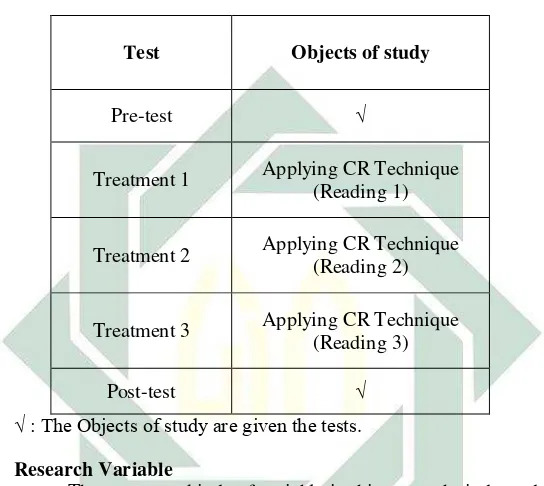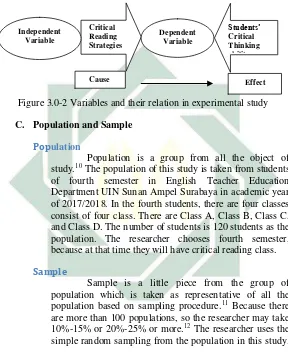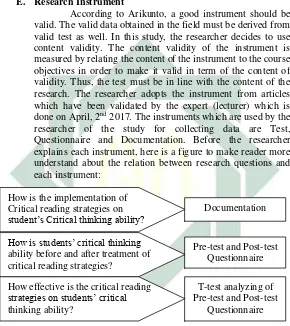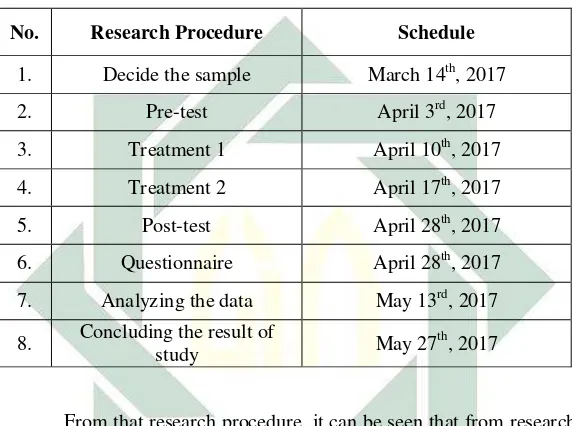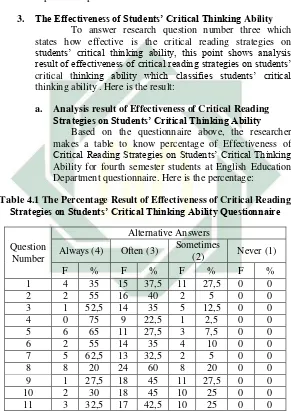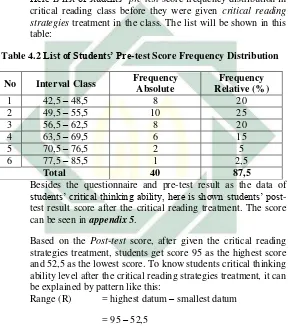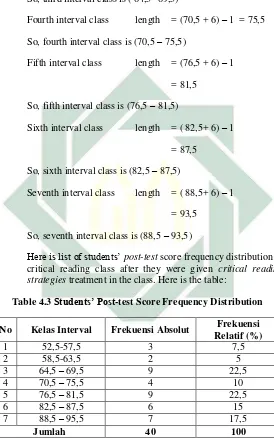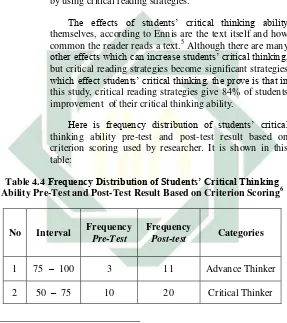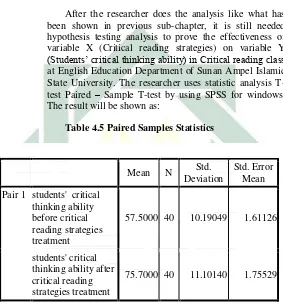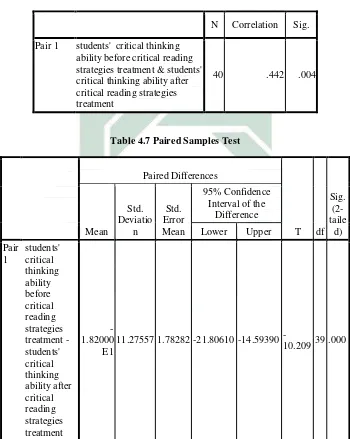i
THE EFFECTIVENESS OF CRITICAL
READING STRATEGIES ON STUDENTS’
CRITICAL THINKING ABILITY AT
ENGLISH TEACHER EDUCATION
DEPARTMENT OF STATE ISLAMIC
UNIVERSITY OF SUNAN AMPEL
THESIS
Submitted in partial fulfillment of the requirement for the
degree of Sarjana Pendidikan (S.Pd) in Teaching English
By
Mukhoyyaroh
NIM D75213082
ENGLISH TEACHER EDUCATION DEPARTMENT
FACULTY OF EDUCATION AND TEACHER
TRAINING
STATE ISLAMIC UNIVERSITY OF SUNAN AMPEL
SURABAYA
vi ABSTRACT
Mukhayyaroh (D75213082), 2017, The Effectiveness of Critical Reading
Strategies on Students’ Critical Thinking Ability at English Teacher Education department at Sunan Ampel State Islamic University, A Thesis, English Teacher Education. Faculty of Tarbiyah and Teacher Training, State Islamic University (UIN) of Sunan Ampel Surabaya. Supervisors: Dra. Irma Soraya and M. Hanafi, MAg.
Keywords: Critical Reading Strategies and Students’ Critical Thinking
Ability
The researcher raised this study because in previous study, there was a
result that less than 70% of students’ previous critical thinking level at
English Teacher Education Department was in developing level without critical reading strategies. Thus, the researcher in this study used critical
reading strategies which are expected to improve students’ critical
thinking level. This study aims to know the effectiveness of critical
reading strategies treatment on students’ critical thinking ability at
fourth semester of English Teacher Education department at Sunan Ampel State Islamic University. This study is Pre-experimental research design by using a quantitative approach in which the data collection process used test method, questionnaire, and documentation. The design was used in this research is one-group pretest-posttest design. Then, the data were analyzed by using statistical formula percentage, frequency distribution, and analysis of two-sample t-test paired using SPSS for Windows. The result is; the improvement in average score of students' critical thinking ability before treatment is 57.5000 and after treatment
students’ score achieve 75.7000, it means that they have increased 11.10140. The hypothesis test in this research used t-test analysis of two samples in pairs. Based on calculation t with a significance level of 5% with (dk) = 40-1 = 39 will be obtained tcount of 10,209 whereas the prices of ttable with significance level of 5% with (dk) = 40-1 = 39 will be obtained ttable 1,684. Tcount value is higher than ttable (10,209> 1,684). So,
Ho is rejected and Ha is accepted. Then, it can be concluded that critical
reading strategies are effective on students’ critical thinking ability in
vii ABSTRAK
Mukhayyaroh (D75213082), 2017, The Effectiveness of Critical Reading
Strategies on Students’ Critical Thinking Ability at English Teacher Education department at Sunan Ampel State Islamic University,. Skripsi. Prodi Pendidikan Bahasa Inggris, Fakultas Tarbiyah dan Keguruan, Universitas Islam Negeri Sunan Ampel Surabaya. Pembimbing I: Dra.Irma Soraya, M.Pd. Pembimbing II: M.Hanafi, MA
Kata kunci: Strategi-strategi Membaca Kritis dan Kemampuan Berpikir Kritis Mahasiswa
xi
TABLE OF CONTENT
APPROVAL SHEET………..ii
EXAMINER APPROVAL SHEET………...iii
DEDICATION SHEET………...v
ABSTRACT………...vi
ACKNOWLEDGEMENT………....vii
PERNYATAAN KEASLIAN TULISAN……….ix
TABLE OF CONTENT……….xi
LIST OF TABLES………...xiii
LIST OF FIGURES………..xv
LIST OF APPENDICES………..xvi
CHAPTER I: INTRODUCTION………...1
A. Research Background……….…1
B. Research Question………...6
C. Objectives of the Study………...7
D. Significance of the Research………..7
E. Hypothesis………...8
F. Scope and Limitation………...9
1. Scope………...9
2. Limitation………9
G. Definition of Key Terms………...10
CHAPTER II: REVIEW OF RELATED LITERATURE……….12
A. Review of Related Literature………...12
1. Effectiveness………...12
2. Reading………...12
3. Critical Reading………...13
xii
5. Critical thinking………..…17
B. Previous Studies………...20
CHAPTER III: RESEARCH METHOD………...25
A. Research Design………...25
B. Research Variable………..27
C. Population and Sample………..28
1. Population………..28
2. Sample………28
D. Data Collection Technique………29
E. Research Instrument………...30
F. Research Procedure………32
G. Data Analysis Technique………..35
CHAPTER IV: RESEARCH FINDINGS AND DISCUSSION……...38
A. Research Findings……….38
1. The Critical Reading Strategies Treatment………...38
2. Significance of Critical Reading Strategies Application…...39
3. The Effectiveness of Students’ Critical Thinking Ability…...41
B. Discussion………..51
1. The Effectiveness of Critical Reading Strategies………...51
2. Critical Reading Strategies as a Treatment of Students’ Critical Thinking Improvement………..52
3. The Improvement of Students’ Critical Thinking Ability…...54
CHAPTER V: CONCLUSION AND SUGGESTION………..61
A. Conclusion……….61
B. Suggestion………..………63
1
CHAPTER I:
INTRODUCTION
This chapter discusses an introduction part that covers several points. The first point is research background, followed by research question, then objective and significance of the research, then scope and limitation, and the last is definition of key terms.
A. Research Background
Reading is an ability to draw meaning from a text and to interpret the information from that text appropriately. Reading is also a behavior, which when someone reads a text, she/he involves conscious and unconscious strategies, including problems solving strategies, to build a model of the meaning, which the writer is assumed to be intended. 1 There are also reading definitions from three linguists who give their argumentation about reading definitions which is different each other. The first, Grabe and Stoller stated that reading can be thought of as a way to draw information from a text and to form an interpretation of that information. They also stated that ideas expressing in this context reading is the process of interpreting meaning and information from pretend materials in terms of using strategies to solve some problems.2 The second, according to Hill Walter R, Reading is what the reader does to get the meaning he needs from textual sources.3 Meanwhile Bond Guy L. and Wagner Eva Bond explained the meaning of reading is the process of acquiring an author’s meaning and of interpreting, evaluating, and effecting upon those meanings.4 From those three definitions, the researcher in this study concluded that reading is not only the way to input information or skill, but
1
Guy L Bond and Eva Bond Wagner, Teaching The Child to Read, (New York: The Macmillan
Company, 1969), p.4
2 Ibid.., p.5 3
Walter R. Hill, Secondary School Reading: Process, Program, procedure, (Boston: Allyn and
Bacon), 1979, p.4
4 Guy L Bond and Eva Bond Wagner, Teaching The Child to Read, (New York: The
Macmillan Company, 1969), p.4
2
also there are other activities in it, such as interpreting, questioning and evaluating. By Bond’s statements, this study relates reading and critical thinking. As Enni stated that reading and critical thinking is related each other.5
Therefore, the researcher used Ennis theory, because reading and critical thinking is related each other. She also stated that critical thinking is the upper three levels of Blooms’ taxonomy of educational objectives (analysis, synthesis and evaluation). Sometimes, the next two levels (comprehension and application) are added. This concept is a good beginning for readers, but it has problems. One of them is those levels are not really hierarchical, as suggested by the theory, but rather are interdependent. For example; although synthesis and evaluation generally do require analysis, analysis generally requires synthesis and evaluation.6
Besides that, Critical thinking in our education environment (learning process) also can be mentioned as profits; thinking creatively, invent new approaches, and anticipate and solve problems in real life context.7 After understanding and aware about ease of critical thinking techniques, students will easily reach those four profits. Other expectation related to the profits, students will be able to apply their voice in their writing, because some of critical thinking strategies also provided to help students to analyze voice in reading which they can freely make voice in their writing. Thus, by the treatment given in this study, the object of study or readers will realize that being critical while reading is important to analyze the information from the reading and it makes readers’ brain become more works well.
As what has been explain above, Critical thinking in reading is not uncommon issue in education environment, since it
5
Amanda Deal – Melissa Rareshide, Critical Reading Manual (Winston: Winston-Salem State University, 2013), 102.
6Robert H.Ennis “Critical Thinking Assesment; Theory into Practice, the Ohio State University”. Vol. 32, No.3, Summer 1993, 180.
7 Elizabeth Spalding – Jian Wang –Emily Lin, “Analyzing Voice in the Writing of
3
has been applied in people’s reading activity, although sometimes they do not realize. In fact, it also could be found in a course. That is critical reading class at English Teacher Education Department. Furthermore, curriculum 2013 in Indonesia stated that class activity, students have to be brave to deliver their opinion and be critical in perceiving a reading given. “Developing creativity, curious about something, skill in searching problem to build critical thinking
which is needed to live smart and study forever” 8
This is the explanation of developed competency of ‘Questioning’ in learning step. Emphasizing this step, students have unlimited perceptions and opinion to show their critical thinking ability in assessing and analyzing voice (writer’s claim) in reading. Other concept of critical thinking also applied in K-13 is in completing system idea point. Here, founded that mono discipline learning style become Multi disciplines learning style, and Passive learning style become Critical learning style. 9 It explains that critical thinking is important in learning process, included also in reading.
Although from those explanations explain that critical thinking is important, but 7 students of 10 students at fourth semester of English Teacher Education Department consider that critical thinking is so difficult to do, because they believe that they cannot expand their knowledge. As what Geller stated that people’s minds are capable of remarkable, incredible feats, yet we don’t use them to their full capacity. In fact, most of us only use 10 per cent of our brains, if that. The other 90 percent is full of untapped potential and undiscovered abilities. It means that our mind is only operating in a very limited way instead of at a full stretch. If people believe with themselves that they have full power over our minds, such as they say; “we had to”, in order to they survive, but as our world has become more sophisticated and we have forgotten many of the abilities we once had.10 This statement has clarified by one of
8
Salinan Peraturan Menteri Pendidikan dan kebudayaan RI nomor 81A Tahun 2013 Tentang Implementasi Kurikulum (Jakarta: Kemendikbud Republik Indonesia, 2013), p.36
9 Peraturan Menteri Pendidikan dan Kebudayaan RI nomor 70 Tahun 2013, Kerangka Dasar dan Stuktur Kurikulum Sekolah Menengah Kejuruan/ Madrasah Aliyah Kejuruan
(Jakarta: Kemendikbud Republik Indonesia, 2013), p.6
10 Academic Skill, Critical Thinking Exercise (Plymouth: University of St Mark &St John,
4
lecturer in English Teacher Education Department of State Islamic University of Sunan Ampel, in her Power Point for Critical reading course. She clarifies that There is no proof that we use only 10% of our brains (it’s a widespread myth!), and there is no connection between this myth and critical thinking.11
Therefore, in reading activity, students are expected to get new information from the reading. In other sides, that expectation is not the only requisite of becoming good reader, because to be good reader, students need to understand what actually reading is. As the explanation above, reading activity is not only about understanding or getting the information inside, but also the readers should involve their critical thinking when they are reading. Seven from ten students of fourth semester of Sunan Ampel Islamic State who have interviewed, have experiences that activity. They states that in this era, they do not really care about what they have to do with the reading, all they need only the information. It happens because they have been facilitated with full sophisticated technology which serves everything, so they think ‘why they need to look for or think about the information they have had’.12
Without realizing that they actually have done critical thinking unconditionally already while analyzing the information, they keep it in mind. Besides that issue, there was a researcher who did research in previous study, she measured students’ critical thinking ability, found that less than 70% students have developing level of critical thinking.13 Means, students need tools to make them realize about critical thinking. Those issues above become problem in this study.
To cover those problems, this study served special thing, that is the implementation of critical reading strategies can be success in analyzing voice in reading. The strategies which will be explained later that hopefully make students or objects of study become good criteria of critical readers. There are numerous reasons why students need to become critical readers. Critical
11
Ana Nurul Laila, Critical Thinking Presentation,Surabaya, April 20th 2015
12 Rizka Nur Yulia Ramadhani, Interview, Surabaya, May 1st 2017
13 Istiharoh, Bachelor Thesis: “The Students’ ability to Think Critically on Critical Reading Class At English Teacher Education Department of Faculty of Education And
5
reading supports academic success and content acquisition at the college level, is a needed life skill for an increasingly complex world, and creates more thoughtful and informed participants in society.14 Thus, related to students’ problems in reading and thinking critically ability, the strategies are served in this study to facilitate students and open up their mind until them aware that it is not very big obstacle, and it can be coped. This study examines how those principles mentioned (critical reading strategies) are effective on students’ critical thinking ability. Related to critical reading strategies to analyze voice which asserted difficult by many students,15 this study also clarifies the use of critical reading strategies to analyzing voice in reading as the scope of this study.
For addition, here are explained the other study related to this topic (Reading voice by critical thinking) in this recent study to show that this recent study is important to be conducted. The previous study was explored voice made by Chinese English teachers in their writings. By organize three weeks workshop in Guangwei Hu, Nanyang Technological University the researchers are success making their object of study apply their voice briefly with many creative variants. While, in this study will emphasize on success of critical thinking techniques to analyze voice in reading for students. Seen, here, the comparison between my study will organized later and the study has implemented. The current study is focusing on reading, while they focused on writing.
Then, other study which is related to the topic inside this recent study is an article by M. Suarsana and G.A. Mahayukti. Entitled The Development of E-modul Problem Solving Orientation
to Increase Students’ Critical Thinking Ability.16
This previous study had purpose to develop e-modul aljabar using problem solving orientation and to know the effectiveness of e-modul in increasing students’ critical thinking ability. Same with the recent
14
Amanda Deal – Melissa Rareshide, Critical Reading Manual (Winston: Winston-Salem State University, 2013), 8.
15 Ana Nurul laila, Interview, Surabaya, January 07th 2017
16 M. Suarsana,- G.A. Mahayukti. “Pengembangan E-modul berorientasi pemecahan
masalah untuk meningkatkan keterampilan berpikir kritis mahasiswa”. Jurnal Pendidikan
6
study, this study measures students’ critical thinking ability by using a strategy, but the previous study used the strategy is for Math class, while the recent study is for reading class. Both studies also do some treatments in the class, but the different is in previous study the treatments are only preparations of the application until the application of the strategy. While, in the recent study, the researcher did the applications directly after pre-test.
Based on other previous study which also measured students’ critical thinking ability, found that less that 70% students’ critical thinking ability at English Education Department Faculty of Tarbiyah and Teachers Training was in developing level (Beginning Thinker in this study term) without any strategies. Thus, this recent study tries to find what critical thinking level that the students have based on the levels in this study by using critical reading strategies.17
Therefore, this study is conducted in English Teacher Education Department program Islamic State University of Sunan Ampel Surabaya. The researcher chooses this place because the program gets A accreditation in 2016, besides, this institution has become a university, and not long time after this, this university will be a world class university. Then, in order to make sure that students of this program is really proper in a program which has A accreditation, this study should be conducted, because according to National Accreditation of University Agency, one of criteria being program which has A accreditation is the students should have good critical thinking ability.18
B. Research Question
From those research backgrounds, this study intended to examine these following questions:
17
Istiharoh, Bachelor Thesis: “The Students’ ability to Think Critically on Critical
Reading Class At English Teacher Education Department of Faculty of Education And
Teacher Training” (Surabaya: State Islamic University Sunan Ampel Surabaya, 2015), i.
7
1. How is the implementation of Critical reading strategies on student’s Critical thinking ability at fourth semester of English Teacher Education Department at UIN Sunan Ampel?
2. How is students’ critical thinking ability before and after treatment of critical reading strategies applied at fourth semester of English Teacher Education Department at UIN Sunan Ampel?
3. How effective is the critical reading strategies on students’ critical thinking ability at fourth semester of English Teacher Education Department at UIN Sunan Ampel?
C. Objectives of the Study
From the questions study, this paper will cover these cases;
1. To describe the implementation of critical reading strategies on students’ critical thinking ability at fourth English Teacher Education Department at UIN Sunan Ampel.
2. To signify students’ critical thinking ability before and after treatment of critical reading strategies applied at fourth semester of English Teacher Education Department at UIN Sunan Ampel.
3. To classify the effectiveness of critical reading strategies on students’ critical thinking ability at fourth semester of English Teacher Education Department at UIN Sunan Ampel.
D. Significance of the Research
Considering of this study purpose, it is expected to give contributions for the lecturer, students, and following researcher. 1. For lecturers.
The result of this study is expected to contribute lecturer’s reading teaching strategies. This study shows the significant of using critical thinking in reading as strategies to analyze voice of writing. The served strategies and the critical thinking rubric from this study are expected to assist the teacher in assessing students’ reading ability too.
8
Other significant result of this study is may presented for the learners to increase their knowledge in using reading strategies. The strategies also help students to respond teacher’s instruction.
3. For following researchers.
For the following researchers, this study is expected become their reference in doing study. The strategies served in this study also need to be improved. They may need the completion from the following researchers..
E. Hypothesis
Hypothesis is temporary answer of research questions, because the answer is only based on relevant theory. It has not been appropriate to the real data. Thus, hypothesis is not the answer which is empiric from the data.19 There are two hypotheses in this study which answered research question number 3. Those are: 1. Hypothesis alternative (Ha). It is patterned if in a study, the Ho
is rejected. This hypothesis explains that there is significant difference between independent variable (X) and dependent variable (Y).
2. Hypothesis o (Ho). It is also called as statistic hypothesis which is tested by statistic. This hypothesis has basic statement which explains that there is no difference between X variable and Y variable which will be examined.
Based on the definitions above and the theories by some experts which have connection with the discussion of the title of this study above, then the hypothesis will be:
1. Hypothesis Alternative (Ha)
Reading Strategies is effective on Students’ Critical Thinking Ability at English Teacher Education Department.
2. Hypothesis o (Ho)
Reading Strategies is not effective on Students’ Critical Thinking Ability at English Teacher Education Department.
19 Sugiyono, Metode Penelitian Pendidikan. Pendekatan Kuantitatif, Kualitatif, dan R&D
9
F. Scope and Limitation
1. Scope
In this study, the researcher focuses on the strategies of critical reading which applied in analyzing voice as the material in class critical reading to measure students’ critical thinking ability, whether they have high level of critical thinking or not. The significant of the strategies are presented for comparison from previous study which did not use the strategies, and to know students’ critical thinking in particular levels. The levels are The Unreflective Thinker, The Beginning Thinker, The Critical Thinker and The Advanced Thinker.20 In reaching highest level (The Advanced Thinker) of critical thinking, the object of study should do each criterion of those levels and elements of critical reading aspects well. Those are Constructing Meaning, Reflecting, Evaluating, Questioning and Contextualizing. These components and the rubric of critical reading which researcher uses are adopted from Winston-Salem State University (Critical Reading Rubric WSSU-General Education).21 The researcher use Advanced Thinker and
Critical Thinker level as the effective measurement of the critical reading strategies served in this study. Thus, if more than 70% of samples have Advanced Thinker and Critical Thinking level after the treatment, the strategies can be declared as effective strategies.
2. Limitation
This study is conducted for fourth semester students in Critical reading class at English Teacher Education UIN Sunan Ampel, in academic year 2017. The method used is Pre-experimental study. For data collection, the researcher gives critical reading comprehension Pretest-Posttest and
20
Linda Elder –Richard Paul, “Critical Thinking Development: A Stage Theory” The Critical Thinking Community, ( http://www.criticalthinking.org/pages/critical-thinking-development-a-stage-theory/483, accessed on March 1st, 2017)
21 Amanda Deal – Melissa Rareshide, Critical Reading Manual (Winston: Winston-Salem
10
questionnaire to the students as two of the instruments of the study. While, documentation becomes another instrument to show the process of critical reading strategies treatment. G. Definition of Key Terms
Concern about some words or terms used in this study might not be understandable, because the terms are from different concept of some sources. The following definitions below will clarify some terms which may become a confusion and misunderstanding of reader’s perceptions.
1. Effectiveness : Fraser defined that effectiveness is a measurement of the match between stated goals and object of study’s achievement. It is always possible to achieve ‘easy’, low-standard goals. In other words, quality in higher education cannot only be a question of achievements ‘outputs’ but must also involve judgment about the goals.22 This study will declare whether critical reading strategies effects students’ critical thinking ability or not. The strategies is effective if the students have The Advance Thinker and Critical Thinker level (4 and 3score) based on the criteria explained by Linda Elder after the application of critical reading strategies.
2. Voice of reading : This term might be the most difficult term to understand in this study. Without knowing what this term means, reader will feel confused so much. Voice of reading is claim or statement stated by author of the reading text.
3. Critical thinking : The upper three levels of Blooms’ taxonomy of educational objectives (analysis, synthesis and evaluation) are often offered as a definition of critical thinking. That brain’s activity also known as questioning, analyzing and criticizing (included in critical thinking aspects used in this study). This study uses critical reading test as the objects of study’s tool to measure students’ critical thinking ability.
22Fraser, ‘Quality in higher education: an international perspective’ in Green, D. (Ed.),
What is Quality in higher Education? 1994 P. 101 (Buckingham, Open University press and society for Research into Higher Education
(http://www.qualityresearchinternational.com/glossary/effectiveness.htm, assessed on
11
4. Strategy : The core of an intended course of action which provides enough guidance.23
5. Critical reading strategies : Strategies which used to measure students’ critical thinking ability in reading class. The teacher conveys the strategies, and the students are compulsory to apply the techniques at their reading activity.
6. Analyzing : Activity of examining critically an essential content of some reading text. Analyzing something is to ask what that something means. It is to ask how something does what it does or why it is as it is. Analysis is kind of thinking people most often ask about to do in their work life or in school. This is not the rarefied or even exclusive province of scholars and intellectuals, but in fact, this is one of people’s common mental activities.
7. Critical reading : Thinking critically in process when doing reading activity. Not only receive knowledge or information from the reading text, but there is another brain’s activity which influences the sensitivity of student’s reading ability.
23 Eric Van den Steen, A Formal Theory of Strategy (Hardvard: Hardvard Business School,
12
CHAPTER II:
REVIEW OF RELATED LITERATURE
A. Review of Related Literature
1. Effectiveness
Fraser defined that effectiveness is a measurement of the match between stated goals and object of study’s achievement. It is always possible to achieve ‘easy’, low-standard goals. In other words, quality in higher education cannot only be a question of achievements ‘outputs’ but must also involve judgment about the goals.1 This study will declare whether critical reading strategies effects students’ critical thinking ability or not. The strategies is effective if the students have The Advance Thinking and Practicing Thinker (4 or 3 score) based on the criteria explained by Linda Elder after the application of critical reading strategies.
2. Reading
Grabe and Stoller stated that reading is the ability to draw meaning from printed and interpret this information appropriately. Reading is a complex behavior, which involves conscious and unconscious use of various strategies, including problems solving strategies, to build a model of the meaning, which the writer is assumed to have intended. The following Grabe and Stoller also stated that reading can be thought of as a way to draw information from a text and to form an interpretation of that information. The ideas expressing in this context reading is the process of interpreting meaning and
1Fraser, ‘Quality in higher education: an international perspective’ in Green, D. (Ed.), What is Quality in higher Education? 1994 P. 101 (Buckingham, Open University press and society for Research into Higher Education
(http://www.qualityresearchinternational.com/glossary/effectiveness.htm, assessed on
February 28th 2017)
13
information from pretend materials in terms of using strategies to solve some problems.2
Heilman et al. stated that reading is a product of interesting with the printed language should be comprehended. This simple definition implies that reading is an activity to have the outcome of comprehending the meaning from the printed or written language. Cline et al said that reading is decoding and understanding written text. Decoding requires translating the symbol of writing system into the spoken words which they represent. Understanding is determined by the purposes for reading, the context, the nature of the text, and the readers’ strategies and knowledge. The ideas carried out in this context reading is concerned with the sign interpretation and determining the objectives of reading from context of the text.3 3. Critical Reading
As what has explained in the previous point, reading is one of English input skills which often related with critical thinking.4 Thus, critical reading is reading activity which also involving critical thinking inside. Then, according to University of Minnesota, critical reading is a highly reflective skill requiring you to “stand back” and get some distance from the text you are reading (even a close reading, getting as close to the text as possible, is a “standing back” as you separate the passage from the rest of the text). Reading critically is not a fast process. Many students do not set aside enough study time for reading (and rereading), and read everything either too quickly or at the same speed. If readers know what they are reading for, they can better distinguish information that can be skimmed
2 Guy L Bond and Eva Bond Wagner, Teaching The Child to Read, (New York: The
Macmillan Company, 1969), p.4
3 Walter R. Hill, Secondary School Reading: Process, Program, procedure, (Boston: Allyn
and
Bacon), 1979, p.4
14
from that which should be more closely examined, and make better use of their reading time.5
Other theory about critical reading comes from Evergreen writing centre. It states that technical and scientific text is written in a very specific form and tone, which must be read actively and critically. So, Critical reading is different from passive reading; an active reader pays close attention to both writing style and content. Then, followed theory is from Stephanie Harvey and Anne Goudvis, as reading researchers and authors of Strategies, state that they believe that constructing meaning is the goal of comprehension. True comprehension goes beyond literal understanding and involves the reader’s interaction with text. If students are to become thoughtful, insightful readers, they must extend their thinking beyond a superficial understanding of the text.6
4. Critical Reading Strategies
There are many critical reading strategies used to engage with text, but there are small numbers of readers who use those strategies consistently, because texts become more sophisticated and the genres are more varied, so students’ application of reading strategies become increasingly complicated.7 Therefore, in this study, the researcher serves seven critical reading strategies by Samuel W followed by the activities which students should do to make students feel easier to apply.8 Here those are:
a. Previewing: Learning about a text before really reading it. Pre viewing enables readers to get a sense of what the text is about and how it is organized before reading it
5 Student writing support, quicktips. Center for writing , University of Minnesota.
http://writing.umn.edu, 1893 612.625.
6 Amanda Deal – Melissa Rareshide, Critical Reading Manual (Winston: Winston-Salem
State University, 2013), 19.
7
Amanda Deal – Melissa Rareshide, Critical Reading Manual (Winston: Winston-Salem State University, 2013), 20..
8 Samuel W – Marllyn C.Salisbury, Critical Reading strategies. Universitas Academics
15
closely. This simple strategy includes seeing what you can learn from the head notes or other introductory material, skimming to get an overview of the content and organization, and identifying the rhetorical situation. b. Contextualizing: Placing a text in its historical,
biographical, and cultural contexts.
When the reader reads a text, the reader reads it through the lens of his own experience. His understanding of the words on the page and their significance is informed by what the reader have come to know and value from living in a particular time and place. But the texts that the reader reads were all written in the past, sometimes in a radically different time and place. To read critically, any reader needs to contextualize, to recognize the differences between his contemporary values and attitudes and those represented in the text.
c. Questioning to understand and remember: Asking questions about the content.
Students are expected to have questions about the content of their readings. A quiz also can be an alternative for them on what they are supposed to be reading. These questions should be designed to help students understand a reading and respond to it more fully, and often this strategy works when the questions are relevant and appropriately phrased. When students need to understand and use new information though it is most beneficial if lecturer encourages them to write the questions that they are asking themselves as they read the text for the first time. With this strategy, they can write questions any time, but in difficult academic readings, they will understand the material better and remember it longer if they write a question for every paragraph or brief section. Each question should focus on a main idea, not on illustrations or details, and each should be expressed in their own words, not just copied from parts of the paragraph.
d. Reflecting on challenges to reader’s beliefs and values:
Examining reader’s personal responses.
16
beliefs, or reader’s positions on current issues. As the reader reads a text for the first time, mark an X in the margin at each point where the reader feels that it is a personal challenge to his or her attitudes, beliefs, or status. Make a brief note in the margin about what the reader feels or about what in the text created the challenge. Now look again at the places the reader marked in the text where you felt personally challenged. What patterns does the reader see in the text.
e. Outlining and summarizing: Identifying the main ideas and restating them in your own words.
Outlining and summarizing are especially helpful strategies for understanding the content and structure of a reading selection. Whereas outlining reveals the basic structure of the text, summarizing synopsizes a selection's main argument in brief. Outlining may be part of the annotating process, or it may be done separately. The key to both outlining and summarizing is being able to distinguish between the main ideas and the supporting ideas and examples. The main ideas form the backbone, the strand that holds the various parts and pieces of the text together. Outlining the main ideas helps reader to discover this structure. When the reader makes an outline, don't use the text's exact words. Summarizing begins with outlining, but instead of merely listing the main ideas, a summary recomposes them to form a new text. Whereas outlining depends on a close analysis of each paragraph, summarizing also requires creative synthesis. Putting ideas together again in readers’ words and in a condensed form shows how reading critically can lead to deeper understanding of any text.
f. Evaluating an argument: Testing the logic of a text as well as its credibility and emotional impact.
17
judgment, or a point of view that the writer wants you to accept. The support includes reasons (shared beliefs, assumptions, and values) and evidence (facts, examples, statistics, and authorities) that give readers the basis for accepting the conclusion. When the reader assesses an argument, he or she is concerned with the process of reasoning as well as its truthfulness (these are not the same thing). At the most basic level, in order for an argument to be acceptable, the support must be appropriate to the claim and the statements must be consistent with one another. g. Comparing and contrasting related readings: Exploring
likenesses and differences between texts to understand them better.
Many authors that readers are concerned with the same issues or questions, but approach how to discuss them in different ways. Fitting a text into an ongoing dialectic helps to increase understanding of why an author approached a particular issue or question in the way he or she did.
Those critical reading strategies became the strategies which measured students’ critical thinking ability. Although the critical reading strategies became the measurement of students’ critical thinking ability, there are other effects of critical reading strategies which are gotten from previous study. Those are; reader can be clear focus in reading, they can read critically, they obtain a deeper and better understanding of the reading material.
5. Critical thinking
18
decide what to believe or do, a person needs to do most of these following solutions which next will be indicators of critical thinking:9
a. Identify conclusions, reasons, and assumptions. b. Judge the quality of an argument, including the
acceptability of its reasons, assumptions, and evidence.
c. Develop and defend a position on an issue.
d. Plan experiments and judge experimental designs of the text.
e. Be open-minded.
This interdependent list of abilities and dispositions could provide some specifications for guiding critical thinking or critical reading testing.10 In this study, the researcher classifies the levels of critical thinking into four (The Unreflective Thinker, The Beginning Thinker, The practicing Thinker, The Advanced Thinker) based on Linda Elder and Richard Paul Theories.11 Each criterion of levels are appropriate with the aspects of critical reading. The criterion will be elaborate in a rubric of critical reading WSSU-General Education next.12
The effects of students’ critical thinking ability themselves according to Ennis are the text itself and how common the reader reads a text.13 In this study, a topic
9H.Ennis “Critical Thinking Assesment; Theory into Practice, the Ohio State University”.
Vol. 32, No.3, Summer 1993, 180.
10Robert H.Ennis “Critical Thinking Assesment; Theory into Practice, the Ohio State University”. Vol. 32, No.3, Summer 1993, 180.
11 Linda Elder –Richard Paul, “Critical Thinking Development: A Stage Theory” The Critical Thinking Community, ( http://www.criticalthinking.org/pages/critical-thinking-development-a-stage-theory/483, accessed on March 1st, 2017)
12
Amanda Deal – Melissa Rareshide, Critical Reading Manual (Winston: Winston-Salem State University, 2013), 102.
13
H.Ennis “Critical Thinking Assesment; Theory into Practice, the Ohio State University”.
19
which could develop students’ critical thinking in critical reading subject, that is analyzing voice. In order to know students’ ability in analyzing voice of writing which means the students are able to develop their critical thinking ability, the researcher gives test which contain of text with voices (opinion).
From the critical thinking criterion by Ennis, analyzing voice exists inside them. Snaza and Lensmire identified two major and influential conceptions of voice. Voice as individual expression is most closely associated with advocates of a process approach to writing and writing workshop. Elbow summed up this position as follows; Voice is an important dimension of texts and we should pay lots of attention to it. Everyone has a real voice and can write with power. Writing with a strong voice is good writing. Sincere writing is good writing. Someone’s voice is his/her true self and my rhetorical power.14
Analyzing itself is an activity of examining critically an essential content of some reading text. Analyzing something is to ask what that something means. It is to ask how something does what it does or why it is as it is. Analysis is kind of thinking people most often ask about to do in their work life or in school. This is not the rarefied or even exclusive province of scholars and intellectuals, but in fact, this is one of people’s common mental activities which done most of time. For example, a reader read a story, inside the story there is a man find himself is followed by a big dog. His first respond is analyzing the situation. Then, the reader thinks what does the dog want from the man?, does the dog mean to be vicious and try to attack him? Or does the dog only feel curious and want to play?. From this example, the reader has done analyzing. People already
20
do analyzing most of time, but sometimes they do not realize that this kind of activity called analyzing.15 Then, analyzing voice is an analyzing activity which defines several opinions or statements by writers or linguists. B. Previous Studies
From the critical reading strategies which have been explained above, in this study, the researcher measured the effectiveness of those strategies on the object’s of study critical thinking ability. Then, based on Jinhong Yu’s study, those critical reading strategies are proven effective on students’ critical thinking ability. In Jinhong’s study, besides critical thinking ability, it is also explained that critical reading strategies have other effect which are good for reading class. That is English reading improvement.16 The difference between this study and that previous study is; this study measured the effectiveness of students’ critical thinking ability using critical reading strategies. While in the previous study, the researcher analyzed what effects which students have after using critical reading strategies.
This study is focus on the effectiveness of critical reading strategies as the way to improve students’ critical thinking ability. Here is the other study which had done and there is the similarity between this recent study and that previous study. In the previous study written by Marioara PATEŞAN, Alina BALAGIU, Dana ZECHIA, Camelia ALIBEC in the article titled; Critical Reading. This article is published by journal Buletin Stiinfic. This previous study explains that one of the four competences subjected to evaluation by the end of the academic years in the military academies, is reading comprehension. For most students it looks as being the easiest skill, but actually it is one that causes lots of trouble. When people read for comprehension you imply active reading, critical thinking, rich vocabulary, a good command of grammar rules, appropriate reading techniques and general knowledge from different fields. At times, readers may come across ideas that are difficult to understand. Language is so important to
15 David Rosenwasser – Jill Stephen, Writing Analytically, Third Edition (Boston:
Thomson Heinle, 2003),2.
16Jinhong Yu, “Analysis of critical reading strategies and its effect on college English
21
your learning as you cannot make sense of a text, mostly academic, or simply readers cannot understand the subject, interpret it and answer the questions or select relevant and appropriate material for your needs. In short, a good command of English is vital when people take the reading comprehension evaluation test. The higher the level which people want to get, the more difficult is to show people’s knowledge and critical understanding of the subject, including some specialist areas.17
The difference between the recent study and that previous study is that this recent study would be focus on the effect of critical reading strategies in improving students’ critical thinking ability. It means, the researcher uses the critical reading strategies in conducting the research, than the previous study uses skimming and scanning strategy in conducting the research. The other difference between this previous study and recent study is that in the recent study, the researcher specifies the research in topic; analyzing voice in critical reading class. Meanwhile, the previous study only focuses on reading comprehension. Last difference between these studies is that; in recent study, the result of the strategies used is to measure students’ critical thinking ability. Meanwhile, in previous study, the motivation of students became the measurement of the result.
In 2015, at English Teacher Education Department also, there was a researcher who did a study about critical thinking ability. She analyses students’ ability to think critically in critical reading class. The objective of her study was to know students’ ability to think critically in critical reading class. Quantitative approach is carried in descriptive design to find the objective above. In process collecting data, first the researcher gives a critical thinking test to the students to know the students` ability to think critically from external perspective. Then, the researcher asks the students to fill in the questionnaire to know their ability to think critically from internal perspective. The questionnaire is a reflective after doing the critical thinking test given and self assess for the students. As the result of this study is the students’ ability to think critically from internal perspective is on developing.
17Marioara PATESAN, “Critical reading Buletin Siintific. Vol. 37 No.1, Sibiu, Romania,
22
The difference between this study and that previous study is she only analyses in what level most of students’ ability to think critically without giving any strategies. While, the recent study measures the effectiveness between before and after giving a treatment of critical reading strategies on students’ critical thinking ability.
Third previous study which is related to this recent study is from University Technology MARA, Pahang, Malaysia.18 In this previous study, the researcher focuses on the importance of reading skills, reading strategies, and metacognitive skills and strategies. These skills and strategies should be given emphasis when teaching reading in schools in order for us to help students develop critical reading skills. Therefore, it is vital for us to understand the theoretical concept of what is meant by these three terms and why is it so important for teachers to adopt them when teaching reading to students. It is hoped that at the end of the discussion, teacher could see the correlation between reading skills, reading strategies, and metacognitive skills and strategies in our objective to develop critical readers among students in schools. Reading skills, reading strategies, and metacognitive skills and strategies are not to be taught in isolation. With these skills and strategies, students will better understand whatever text given to them. Teachers should employ these strategies in order for the teaching of critical reading skills are more meaningful and beneficial for the students. In other words, when teacher teaches critical reading skills to students teacher will develop them to be critical thinkers as well because when they do critical reading it will lead to critical thinking (critical reading will come first before critical thinking). Thus, this will not only prepare them to be better critical readers in schools but the researcher also hope we could produce better school leavers who could survive in the real world.
Thus, the similarities between the previous study and the recent study are; both study use reading class as the objects of study, and both study expect critical reader as the result of the study. The differences between this recent study and the previous
18 Norbaiyah Abd Kadir, Roose N Subki, Farah Haneem Ahmad Jamal, Juhaida Ismail,
“The importance of teaching Critical reading skills in a Malaysian reading classroom”.
23
study are; in the recent study, the researcher will apply critical reading strategies to know students’ critical thinking level. While, the previous study only explains the importance of reading skills, reading strategies, and metacognitive skills and strategies. Beside it, the researcher in the previous study tries to see the correlation between reading skills, reading strategies, and metacognitive skills and strategies in researcher’s objective to develop critical readers among students in school.
Other previous study is by Kowiyah, an elementary education lecturer of UHAMKA. The title is Critical Thinking Ability. This previous paper explains that critical thinking ability is an cognitive activity or process and action of mental to obtain knowledge, understanding and skill in a hope that is able to find way out and performs decision deductively, inductive and as according to its step which is performed with thinking exhaustively about things which can be reached by experience of someone, inspection and performs logical common sense which is measured by through interpretation efficiency, analysis, assumptions recognition, deduction, evaluation inference, explanation, and self regulation.19
This previous study and this recent study discuss about critical thinking ability, but the differences between both studies are; the previous study explains definition, activities and steps of critical thinking. While, in this recent study, critical thinking becomes a measurement for the objects of study after the strategies given by researcher.
Last previous study which has similarity with this recent study is from a thesis titled Students’ ability in Constructing
Reading Question items in Critical Reading Class by Risalatil Umami. This research was conducted to know students’ ability in constructing reading question items based on cognitive level of bloom taxonomy’s perspective and their difficulties in constructing the questions. This research use descriptive qualitative method. The subject of the research are twenty five students of critical reading class academic year 2015-2016 faculty of education and teachers training UIN Sunan Ampel Surabaya. The test and questionnaire
19Kowiyah, “Kemampuan Berpikir Kritis”. Jurnal Pendidikan Dasar. Vol.3, No.5,
24
were used as the instrument of this research. The test was used to obtain the data about the students’ ability in constructing reading question items based on cognitive level of bloom taxonomy’s perspective. Furthermore, the questionnaire was used to obtain the data about students’ difficulties in constructing question items. The finding shows that the students’ ability in constructing reading question items based on cognitive level of bloom taxonomy’s perspective are fair. In low-thinking level of bloom taxonomy; remembering 11,38% question of the students in this level, 15,44% students question in understanding level, and 22,76% students’ question in applying level. Therefore, in high-level thinking of bloom taxonomy’s perspective; 29,26% students’ question were in analyzing level, 18,69% students’ question were in evaluating level, and only 2,34% students’ question were in creating level. It means still there are students in low-thinking level. Whereas, most of the students’ difficulties in constructing question are on grammar terms. Based on the data finding in this research, some suggestions are given to the lecture, especially for the lecture who teaches in critical reading class to increase the students’ ability in critical thinking. And for the students especially for university’s students to increase their ability to think critically, because they are a university’s students, they must have a critical thinking. It is also suggestion for the next researcher to conduct such this research from internal and external aspect or measured the students’ ability in constructing question from other perspective.20
This previous study and the recent study have the same class as the object of studies. Both studies also involve critical thinking as the objects’ of study measurement, but there is still differences between them. The topic used in the recent study is analyzing voice, while the topic used in this previous study is constructing reading question items. Other difference between them is the recent study use four levels of critical thinking theory by Linda Elder, while the previous study used bloom taxonomy as the level of thinking. Out of those previous studies, once more, this
20Risalatil Umami, Bachelor thesis: “Students’ Ability in Constructing Reading Question items in Critical Reading Class”. (Surabaya: State Islamic University of Sunan Ampel,
25
25
CHAPTER III:
RESEARCH METHOD
Research is a study which is done by researcher through careful observation of a problem until found the problem solving.1 Thus, a research has close relation with methodology. Methodology is a process, principle and procedure which is used to find the answer of the problem.2 Generally, research method is scientific way to get data with specific purpose. Research method is also decipherable as scientific way to get valid data with purpose which can be gotten, developed, and proved from specific knowledge until it can be used to solve the problem.3 In this study, here are the research methods:.
A. Research Design
The method which is designed in this study is experimental research. Experimental research is the only research which exam the hypothesis correctly which is about cause and effect relation.4 There are some kinds of experimental designs, but the researcher chooses to use Pre-experimental design (nondesigns)5. The researcher chooses this design of study, because there might be another reason outside variable independent in reaching variable dependent. This case might happen, because there is no control variable, and the sample is not chosen by random sampling. This Pre-experimental research is conducted to find out is there any effect of the critical reading strategies on students’ critical thinking ability. In this research, researcher uses One-Group Pretest-Posttest Design as one of type of pre-experimental research to find the result whether variable independent effects the variable dependent. Thus, the objects of study will be given pretest and posttest. Before the objects of study are given a treatment, there will be pretest. Through
1
Zainal Arifin, Penelitian PendidikanMetode dan Paradigma Baru, (Bandung: PT Remaja Rosdakarya, 2012), 2.
2 Deddy Mulyana, Metodologi Penelitian Kualitatif Paradigma Baru Ilmu Komunikasi dan Ilmu Sosial Lainnya, (Bandung: PT Remaja Rosdakarya, 2008), 145
3
Sugiyono, Metode Penelitian Pendidikan Pendekatan Kuantitatif, Kualitatif, dan R&D, (Bandung: alfabeta, 2016), 3.
4 Nana Syaodih Sukamadinata, Metode Penelitian Pendidikan, (Bandung: PT Remaja
Rosdakarya, 2013), 194.
5 Furchan Arief, Pengantar Penelitian Dalam Pendidikan (Yogyakarta: Pustaka Pelajar),
p.380
26
this way, the result of the treatment could be known accurately, because the result will compare students’ critical thinking ability before and after the treatment. This design can be described below:
X : Treatment
O1 : Pretest Score (Before Treatment) O2 : Posttest Score (After Treatment) Figure 3.0-1 Design of Study
The effect of treatment on students’ critical thinking ability = (O2 – O1).6
Experimental research is the most pure of quantitative, because all principles of quantitative can be applied in this method. Thus, the approach which is used in this research is quantitative approach and it would be analyzed using SPSS 16 (Statistic Product and Service Solutions). Quantitative approach is a research which use numbering data as the tool to get information from what the researcher want to know, the collected numbers become a result which is analyzed by statistics method.7 In this quantitative research, the data is processed by statistics technique which needs to consider the sampling technique. As a whole, this study is conducted to chosen sample.8 Quantitative approach in this study analyzes the result of pre-test, post-test and questionnaire which will be analyzed with T-test statistics. By those scores, the researcher could analyze whether Critical reading techniques improve students’ critical thinking ability or not.
In collecting the data, the researcher designs the activity of the study by giving treatment application, pretest and posttest as what has been explained above. Here, the researcher provides a scheme of rundown of her study:
6
Prof. Dr. Sugiono. Metode Penelitian Pendidikan: Pendekatan Kuantitatif, Kualitative dan R&D (Bandung: Alfabeta 2016), p.110
7 Margono, Metode Penelitian Pendekatan, (Jakarta: Rineka Cipta, 1997), 103-105. 8 Suharsimi Arikunto, Prosedur Penelitian Suatu Pendekatan Praktik (Edisi Revisi 11),
(Jakarta: PT Rineka Cipta, 2006), 310.
[image:37.420.82.354.111.354.2]
27
Table 3.0-1 Research Scheme
Test Objects of study
Pre-test √
Treatment 1 Applying CR Technique (Reading 1)
Treatment 2 Applying CR Technique (Reading 2)
Treatment 3 Applying CR Technique (Reading 3)
Post-test √
√ : The Objects of study are given the tests.
B. Research Variable
There are two kinds of variable in this research: independent and dependent variable. Independent variable is the variable which is influence other variable. The dependent variable is the variable which is affected by independent variable.9 Independent variable resembles the cause which means that the technique which is used become the cause of the impact given after treatment. Meanwhile, Dependent variable resembles the effect derived from treatment of critical reading strategies. Thus, the independent variable of this research is Critical reading strategies and the dependent variable is the students’ Critical thinking ability.
9
[image:38.420.74.362.99.457.2]
28
Figure 3.0-2 Variables and their relation in experimental study C. Population and Sample
Population
Population is a group from all the object of study.10 The population of this study is taken from students of fourth semester in English Teacher Education Department UIN Sunan Ampel Surabaya in academic year of 2017/2018. In the fourth students, there are four classes consist of four class. There are Class A, Class B, Class C, and Class D. The number of students is 120 students as the population. The researcher chooses fourth semester, because at that time they will have critical reading class.
Sample
Sample is a little piece from the group of population which is taken as representative of all the population based on sampling procedure.11 Because there are more than 100 populations, so the researcher may take 10%-15% or 20%-25% or more.12 The researcher uses the simple random sampling from the population in this study.
10
Burhan Bungin, Metodologi Penelitian Kuantitatif Komunikasi, Ekonomi, dan Kebijakan Publik Serta Ilmu-ilmu Sosial Lainnya, (Jakarta: Kencana Prenada Media Group, 2011), 109.
11 Maman Abdurahman dkk, Dasar-dasar Metode Statistika Untuk Penelitian, (Bandung:
Pustaka Setia, 2011), 129.
12
Suharsimi Arikunto, Prosedur Penelitian Suatu. . ., 134.
Students’ Critical Thinking ability Critical
Reading Strategies
Dependent Variable Independent
Variable
Effect
29
The researcher takes class B (consist of 42 students) because the lecturer of this class states that the students are relative homogeny (reading score), and because that class is 35% of 120 population, thus, those sample is representative of all the population.13
D. Data Collection Technique
Collecting data is systematic procedure and standard to get data which is needed. Data collection technique is important step, because data will be used to solve the problem to examine hypothesis which has been patterned.14 There is always a connection between Data Collection Technique with Research Questions. In research question number one, it tries to describe the implementation of critical reading strategies on students’ critical thinking ability. In this data collection technique, documentation such as lesson plan and recording of the critical reading strategies become the data collection technique to answer research question number one.
Next, to answer research question number two which tries to signify students’ critical thinking ability before and after treatment of critical reading strategies, the researcher gives reading comprehension pre and post-test to the one group. The pre-test and post-test consist of 10 questions, all of them are essay. Each question, the researcher gives score based on the critical thinking levels between 1 until 4. After the students pass the test, all score of the pre-test and the post test will be noted then calculated the average the score between before and after the treatment. Besides it, to answer research question number two, questionnaire became the data collection technique also.
Then, in research question number three which tries to classify the effectiveness of critical reading strategies on students’ critical thinking ability, the data collection technique is documentation. The researcher chose video and lesson plan
13 Ana Nurul Laila, Interview,Surabaya, March 20th 2017
30
as the data collection technique which are suitable with research question number three.
E. Research Instrument
[image:40.420.73.363.108.434.2]According to Arikunto, a good instrument should be valid. The valid data obtained in the field must be derived from valid test as well. In this study, the researcher decides to use content validity. The content validity of the instrument is measured by relating the content of the instrument to the course objectives in order to make it valid in term of the content of validity. Thus, the test must be in line with the content of the research. The researcher adopts the instrument from articles which have been validated by the expert (lecturer) which is done on April, 2nd 2017. The instruments which are used by the researcher of the study for collecting data are Test, Questionnaire and Documentation. Before the researcher explains each instrument, here is a figure to make reader more understand about the relation between research questions and each instrument:
Figure 3.3 Research question and instrument relation 1. Documentation
Documentation is tools to document a proof of study, such as video, picture and written notes. So, documentation is a instrument which aims to analyze How is the implementation of
Critical reading strategies on
student’s Critical thinking ability? Documentation
Pre-test and Post-test Questionnaire T-test analyzing of Pre-test and Post-test
Questionnaire How is students’ critical thinking
ability before and after treatment of critical reading strategies?
31
video, picture or photograph and written note tools.15 In this study, the researcher uses lesson plan, photograph and video when critical reading strategies implementation as the instrument. This instrument can be a support to answer research question number one, because it shows the lesson plan, video and photograph of the critical reading strategies implementation process.. The lesson plan and photograph will be enclosed in appendix.
2. Test (Pre and Post-test)
Test is a measurement technique which consists of questions or assignment which need to be answered by the respondent. The test used in this study is English Reading test. There are two steps of test in this study, named pre-test and post-pre-test. Pre-pre-test will give before the material is taught and it will be done to find out the student’s original competence. Then post-test is given in the last meeting in class after doing the treatment. Pre-test and post-test would be used in the one group chosen as the objects of study. The pre-test
